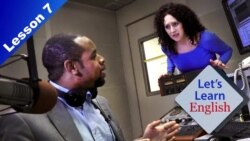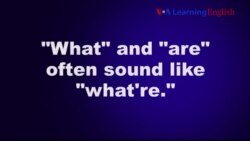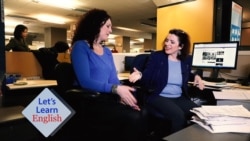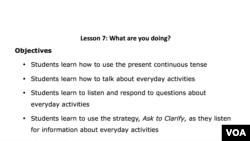Summary 简介
Anna is starting her work at VOA News. She goes around the office meeting her co-workers. She learns they are all busy.
Anna开始在美国之音新闻报上班。她跟新同事见面,发现他们都很忙。
Speaking 口语
In this video, learn to say the new words. Also, learn how to use the Present Continuous tense and ask questions to clarify. You can also download the worksheet and practice with a friend.
看视频,学习新单词发音,学习使用现在进行时态,提问澄清。下载跟朋友一起练习。
Pronunciation 发音
In this video, you learn about how Americans shorten verbs in the Present Continuous tense. You will also learn a shorter for of the question phrase, "What are you doing?"
Conversation 对话
Writing 写作
What are you doing now? What are your friends doing? Here is an example: "I am reading and my friends are listening to music." Send us an email or write to us in the Comments section.
发电邮告诉我们,你现在正在做什么。
You can also download the worksheet. Practice writing the activity words.
下载,练习书写各种行为动词。
Learning Strategy 学习技巧
Learning Strategies are the thoughts and actions that help make learning easier or more effective. The learning strategy for this lesson is Ask to Clarify.
本课学习技巧是如何通过问问题来了解情况。
In the video you see Anna ask Amelia: "What are you doing?" Amelia answers, "I’m reading." Then Anna asks a question to clarify: "Are you reading the news?
Asking a question to clarify is a very useful learning strategy, because it helps you get more information. You can also learn new words when someone explains more about what they said.
Write to us in the Comments section or send us an email about how you ask questions to clarify what you want to know. Teachers, see the Lesson Plan for more details on teaching this strategy.
发电邮或是写评论,说说你是如何通过提问题,来了解情况的。
Listening Quiz 听力测试
Desktop Computer: Click here to go to the listening quiz. Click on the button below if you are on a mobile device or our mobile site. Each question has a video. Play the video and listen for what people are doing.
使用电脑的用户:点击这里进行听力测试。手机或平板电脑用户,点击下面的Start quiz开始测试。每个问题有一段视频,看视频,了解大家都在做什么。
(If the quiz does not work for you here please see the side column or use this link.)
New Words 新词汇
boss – n. the person whose job is to tell other workers what to do
boss - 名词,老板
bother – v. to annoy someone or to cause someone to feel annoyed
bother - 动词,打扰
busy – adj. actively doing something
busy - 形容词,忙碌的
excited – adj. very enthusiastic and eager about something
excited - 形容词,兴奋的
nervous – adj. having or showing feelings of being worried and afraid about what might happen
nervous - 形容词,心情紧张的
news – n. information that is reported in a newspaper, magazine, or a television news program
news - 名词,新闻
office – n. a building or room in which people work at desks doing business or professional activities
office - 名词,办公室
read – v. to look at and understand the meaning of letters, words, symbols, etc.
read - 动词,读
record – v. to store (something, such as sounds, music, images, etc.) on tape or on a disk so that it can be heard or seen later
record - 动词,录音
show – n. a television or radio program
show - 名词,电视或广播节目
work – v. to do things as part of your job
work - 动词,工作
write – v. to create (a book, poem, story, etc.) by writing words on paper or on a computer
write - 动词,写作
______________________________________________________________
Free Materials
免费学习辅助材料
Download the VOA Learning English Word Book for a dictionary of the words we use on this website.
Each Let's Learn English lesson has an Activity Sheet for extra practice on your own or in the classroom. In this lesson, you can use it to practice writing and using action verbs in the Present Continuous tense.
For Teachers
教师资源
See the Lesson Plan for this lesson for ideas and more teaching resources. Send us an email if you have comments on this course or questions.
Grammar focus: Present continuous tense; Questions for clarification
Topics: Everyday activities; Checking understanding
Speaking & Pronunciation Focus: Asking questions to clarify; Shortened form of Present Continuous verbs.
_______________________________________________________________
Now it's your turn. Send us an email or write to us in the Comments section below or on our Facebook page to let us know what you think of this lesson.














